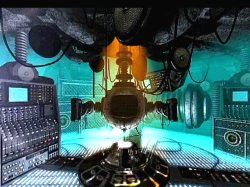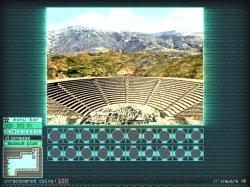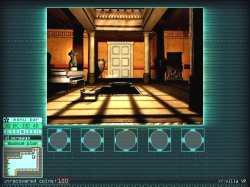|
OPSYS
 This is the first review I have written without finishing the game. There are two reasons for that. The first is that there is a competition connected with the game in which the first person to complete it wins $10,000. It is therefore only fair to alert potential players to the chance of winning prior to my finishing it and running off with the prize. The second reason is that I don't know when I will finish it, and there are several reasons for that.
The game commences with a news bulletin about the theft of 100 coins from the museum of Cypriot coinage. There is a reward for their return, being the $10,000 referred to above and the aim of the game is therefore to find and recover the coins. You are not given any more information than that. This is the first review I have written without finishing the game. There are two reasons for that. The first is that there is a competition connected with the game in which the first person to complete it wins $10,000. It is therefore only fair to alert potential players to the chance of winning prior to my finishing it and running off with the prize. The second reason is that I don't know when I will finish it, and there are several reasons for that.
The game commences with a news bulletin about the theft of 100 coins from the museum of Cypriot coinage. There is a reward for their return, being the $10,000 referred to above and the aim of the game is therefore to find and recover the coins. You are not given any more information than that.
Some poking around will eventually enable you to access a time machine that can take you to nine different locations, each in different time periods, from 500BC up to 1960, and it is in those locations plus the one in which you start that you will hunt for the coins. There are a discrete number of coins in each period, and quite usefully you will be told via a schematic how many coins you are looking for in each place. An image of each coin you find will appear in the schematic, so you can easily see how many you still have to find at that location, and a running total of all coins found is kept on a counter at the bottom left of screen.
The prospect of time travelling to search for coins is quite appealing, as are the destinations - they include a Greek temple, an old amphitheatre, a Byzantine church, a Roman villa. However, I found the reality far less so. The time machine essentially opens a window on the particular time period, and whilst you interact with the revealed world you do so through the window. If you have ever played SPQR, it is exactly the same concept as the Navitor in that game (indeed there is much about the look and "feel" of this game that reminded me of SPQR).
Regrettably the window does not fill the screen; a sizeable portion of the game screen is taken up with a bottle green background in which there is not much at all, apart from the schematic indicating how many coins you have to find. There is a menu that you can access to bring up more information, including museum information on the coins of the particular periods you are visiting, but the failure to use the whole screen creates an overall impression of watching from afar, rather than "being" there.
This dislocation is accentuated by the fact that I didn't find many of the locations terribly engaging. Two of the locations (the city siege and the city maze) provide a nice contrast to the others, and the building in which you start is different because it is not accessed through the time machine, but on the whole they were rather drab and predominantly static, and to me, they functioned essentially as props for the puzzles. I appreciate that a busy immersive experience is probably not what this game is about, but I find that if the game world is uninteresting, or if it becomes so throughout the course of the game, my interest wanes accordingly.
That interest can of course be perked up by the plot or the characters or the puzzles (don't forget also the $10,000), and whilst there is virtually no plot here and I have yet to encounter a single other character, there are lots of puzzles. In fact, the lack of those other aspects means this game for me falls firmly on the puzzle game side of the dividing line.
 The puzzles here range from relatively easy to very difficult. As I haven't finished the game, some of the latter may ultimately prove to be less difficult, but not at present. Some may also prove to be beyond me - I have to admit there are a couple where so far I haven't got a clue. Of course, if you are going to give away $10,000, and you don't want to give it away 1 week after the game is released, you are not going to make the puzzles easy.
There is a good variety of puzzles in the game, both in terms of content and skill level. Some simply involve meticulously looking in the right places, whilst others require the piecing together of clues in order to gain access to secret rooms or locked vaults. Often you need to give some thought to exactly what the puzzle is asking you to do. Some require you to do a bit of reading through the relevant museum material - you will simply be unable to do the tomb puzzle if you won't study. There is also a maze, although the top down perspective makes it fairly easy to navigate. And there are others which are like none of the above - my favourite was one which was like a mission from Age of Empires.
You can complete the time periods in any order you like, and you can leave and come back without completing them, and without losing any coins you might already have found. Access to them is easy - click on the period you want on the menu bar, and you are instantly transported to that period. Helpfully, if you have visited that period before, you arrive back at the same point in the location at which you decided to leave. So jumping around and trying to nut out bits and pieces of puzzles is pain free. If you have a brain wave, you can instantly go back and try it out.
When you find all the coins at a particular location, you get a news break in which the curator of the museum reports that the coins from that period have all been recovered and thanking the person responsible. Further access to that period is then denied.
I experienced a fairly high degree of satisfaction when I solved a puzzle and got some coins, and the first time I was thanked by the curator I felt particularly chuffed. There can also be a high degree of frustration when stuck - in two puzzles I have acquired critical information but cannot put it into practice. Yet that is the inherent quality of puzzling. The puzzles here range from relatively easy to very difficult. As I haven't finished the game, some of the latter may ultimately prove to be less difficult, but not at present. Some may also prove to be beyond me - I have to admit there are a couple where so far I haven't got a clue. Of course, if you are going to give away $10,000, and you don't want to give it away 1 week after the game is released, you are not going to make the puzzles easy.
There is a good variety of puzzles in the game, both in terms of content and skill level. Some simply involve meticulously looking in the right places, whilst others require the piecing together of clues in order to gain access to secret rooms or locked vaults. Often you need to give some thought to exactly what the puzzle is asking you to do. Some require you to do a bit of reading through the relevant museum material - you will simply be unable to do the tomb puzzle if you won't study. There is also a maze, although the top down perspective makes it fairly easy to navigate. And there are others which are like none of the above - my favourite was one which was like a mission from Age of Empires.
You can complete the time periods in any order you like, and you can leave and come back without completing them, and without losing any coins you might already have found. Access to them is easy - click on the period you want on the menu bar, and you are instantly transported to that period. Helpfully, if you have visited that period before, you arrive back at the same point in the location at which you decided to leave. So jumping around and trying to nut out bits and pieces of puzzles is pain free. If you have a brain wave, you can instantly go back and try it out.
When you find all the coins at a particular location, you get a news break in which the curator of the museum reports that the coins from that period have all been recovered and thanking the person responsible. Further access to that period is then denied.
I experienced a fairly high degree of satisfaction when I solved a puzzle and got some coins, and the first time I was thanked by the curator I felt particularly chuffed. There can also be a high degree of frustration when stuck - in two puzzles I have acquired critical information but cannot put it into practice. Yet that is the inherent quality of puzzling.
Movement within each location seen through the window is predominantly done by holding the mouse button and dragging the cursor across the screen. That will cause the scene to rotate a full 360 degrees, and you can also drag it up and down to a certain extent. The cursor will change as it moves over items or things with which you can interact, and will change to indicate what you can do. There is no list of the particular icons in the manual, but they will be familiar enough to most gamers (open hand, pointing finger etc - although there is one I have encountered which I cannot fathom). There are points at which your cursor becomes an arrow, meaning you can move forward, some of which generate a short "motion" cut scene.
Some confusion is caused by the fact that the cursor sometimes becomes an open hand, indicating you can grasp something, yet you can in fact do nothing. Sometimes this hand seems to indicate that something else must be done first (eg there is something behind a trap door which you must first open), at other times it seems to be there as a red herring.
You can also zoom in and out by using the shift and control keys.
Most locations have a music score, and there are some ambient sounds. Subtitles are not available, which given the lack of dialogue does not really matter, except for the information provided by the talking statue. You can also choose to play in English or Greek.
 The game uses QuickTime, and plays from the CD. I did not experience any lag because of this, nor any technical glitch. It will play on IBM or Macintosh machines. You can save as often as you like but need to designate where the saves will be kept. You have to work through Windows boxes to do this. The manual is short, and whilst a bit more info on some things (cursors, game saves, menu operation) would have helped, it will not hinder most game players
Finally, according to the website, the Bank of Cyprus Cultural Foundation collaborated with the developers of the game by allowing usage of various material including coin images, coin descriptions and historical texts. You can access the website through a hotspot in the time machine room. The game uses QuickTime, and plays from the CD. I did not experience any lag because of this, nor any technical glitch. It will play on IBM or Macintosh machines. You can save as often as you like but need to designate where the saves will be kept. You have to work through Windows boxes to do this. The manual is short, and whilst a bit more info on some things (cursors, game saves, menu operation) would have helped, it will not hinder most game players
Finally, according to the website, the Bank of Cyprus Cultural Foundation collaborated with the developers of the game by allowing usage of various material including coin images, coin descriptions and historical texts. You can access the website through a hotspot in the time machine room.
Despite what I said at the start, I do not expect to gallop off with the prize, and will not be playing the game continuously in order to do so. For me, it is not a game that will command my undivided attention. It will remain on my desk to be dipped into from time to time, to see if I can make some headway on the puzzles. You will either play this game to try and win $10,000, or because you like varied and challenging puzzles, or both.
Copyright © Steve Ramsey 2001.
All rights reserved.
System Requirements:
PC: Windows 95/98, Pentium II 300 MHz, 32MB RAM,24X CD-ROM, 640 x 480 display, High Colour, Sound card
Mac: 200 MHZ, OS 8.1 or higher, 48MB RAM, 24X CD-ROM, 640 x 480 display, thousands of colours
|

